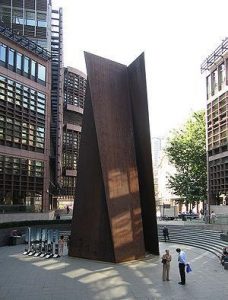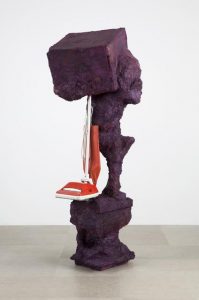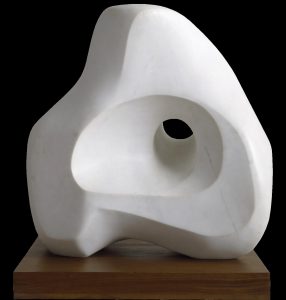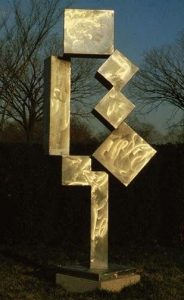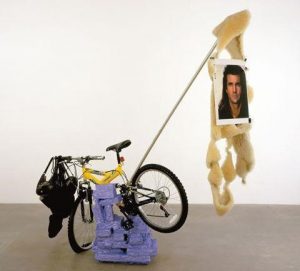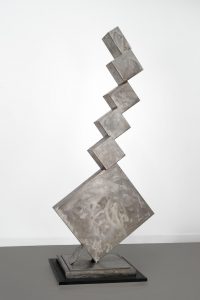Schlock Sculpture
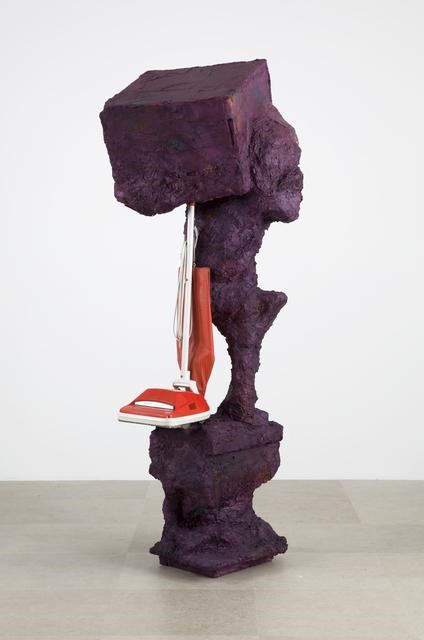
When you look at the work of an artist like Richard Serra, or better yet, stand next to a classic Serra piece, you begin to understand how important the physical problem of balance and uprightness is for contemporary sculpture. Take one such classic work, Fulcrum (1987). The work consists of five fifty-five-foot tall slabs of COR-TEN steel. It dominates one of the entrances to the Liverpool Street station in London. Standing next to Fulcrum can be genuinely scary, all the more so when (and if) you realize that the huge slabs of steel are balanced one against the other simply by weight and angle. So, these slabs of steel can, theoretically, kill you. In fact, Serra’s sculptures have killed before and might do so again. Serra’s Sculpture No. 3 famously ended the life of a rigger named Raymond Johnson, who was crushed by it during installation at the Walker Art Center in 1977.
Richard Serra, Fulcrum (1987)
Hearing Serra talk about sculpture, it’s hard not to come away with the feeling that, while he has no desire directly to harm anyone with his art, he endorses a kind of aggressive and confrontational attitude toward artmaking. “Art, for the most part,” he has said, “is about concentration, solitude and determination.” The quietness of the steel versus the implied sense of power and violence-it is all part of the Richard Serra act.
Then there are the sculptures of Rachel Harrison, who is a generation younger than Richard Serra (Serra was born in 1938, Harrison in 1966) and whose sculptural work is intentionally shoddy in every way that Serra’s is intentionally not. Walking around Harrison’s recent major show at the Whitney Museum (which closed in mid January) and knocking a sculpture over would have resulted in nothing more serious than a light bump on the head, though Harrison’s sculptures do, indeed, threaten to fall over just as obstinately as any Serra. Sculpture, even in its most postmodern variant at the hands of someone like Harrison, still has to deal with the earth’s pesky rotation, and the incumbent heaviness of physical things. At its root, the formal problem of sculpture is the issue of gravity and how you deal with it. But for Serra, it is a huge and portentous matter that things fall down, and he’s gonna play with that dangerous energy all the way to the bank. For Harrison, the fact that shit falls down, or that it ever manages to stand up in the first place, is mostly hilarious.
A sculpture like All in the Family (2012) is a case in point. The work is described as being made of wood, polystyrene, cement, wire, acrylic paint, and a Hoover vacuum cleaner. The “sculpting” of the sculpture is half-assed at best. All in the Family is bulbous and awkward and misshapen. The cube-like mass at the top of the sculpture looks seriously unbalanced and is only held up there by the fact that a vacuum cleaner has been jammed into the center, its handle giving the cube an extra boost. The cement and polystyrene give the work a vaguely stalagmite feel, but any natural resonances are pretty well cancelled by the God-awful purple paint with which the entire sculpture, minus vacuum cleaner, is slathered.
Rachel Harrison, All in the Family (2012)
All in the Family is basically a giant mess. So what to make of it? And why, while we’re at it, does it bear the title of the classic 1970s television show with Archie Bunker and the gang?
The answer, at least in part, is that Rachel Harrison was born in 1966 and, like most American GenXers, has All in the Family deeply embedded in her psyche. So why not put it in a sculpture? Indeed, most of Rachel Harrison’s sculptures are littered with the debris of popular culture. She is no minimalist. Her first show, back in 1996 at the Arena Gallery in NYC, was titled Should home windows or shutters be required to withstand a direct hit from an eight-foot-long two-by-four shot from a cannon at 34 miles an hour, without creating a hole big enough to let through a three-inch sphere? The title was a reference to a newspaper article about Hurricane Andrew. The show included a typical mix of enigmatic photographs, clunky objects, trash bags hung at strange angles by lengths of rope, confusing interior spaces, and cans of peas. The art-going public was largely confused, but also intrigued. Harrison’s work continued on a kind of slow burn for the next decade or so. By the early Twenty Tens, Harrison was regularly being discussed as a major artist of her generation. Peter Schjeldahl ran a long feature on Harrison at The New Yorker in 2014. And then, just at the end of last year, the Whitney Museum put up an extensive mid-career survey of her work. Important articles by the likes of David Salle in The New York Review of Books and Hal Foster at Artforum followed. Rachel Harrison has very much arrived, and with a trash bag filled with old wigs, a few ceramic tchotchkes, some styrofoam, and a can of creamy milk chocolate Slim Fast.
The key to Rachel Harrison’s work (if there is anything like a key) comes, I would say, with a bit of consideration of the history of sculpture over the last 20,000 years. Let’s start with the more recent history. Sculpture in the western world, as we all know, more or less dropped its figurative and representational content in the late 19th and early 20th centuries. No more statues of important dudes riding horses. No more classical ladies in classical poses, the marble burnished and polished just so. From Brancusi to Barbara Hepworth, from Camille Claudel to David Smith, sculpture was going to break itself down and start over. The great sculptures of the 20th century tend to be abstract, or at least make a hard move in that direction. They are studies in basic shapes, the formal properties of slabs of stone or sheets of concrete or blocks of wood or piles of post-industrial waste. The idea that the matter making up a sculpture should be shaped and formed to look like something else-the skin and bones of a human being, for instance-has been generally discarded. Instead, sculpture was set free to pursue its own forms, whether the smooth, pierced forms of a classic Hepworth or indifferent piles of rubber scraps by Robert Morris.
The funny thing about the hyper-Modernity of these 20th century sculptural forms is that, in their simplicity and often lack of parts, the works harken back to the archaic. The most basic sculptural act is, it could be argued, simply to stick a rock or stone in a specific spot. Perhaps this act marks the spot as historically significant, creating a memorial of sorts. Or perhaps the ongoing activity in that spot is important, like worship or ritual. In the biblical Book of Genesis, for instance, when Jacob wakes from dreaming about his ladder, he realizes that the spot in which he had this dream must be of extreme significance. He realizes the spot is a powerful place that connects heaven and earth. “And Jacob rose up early in the morning, and took the stone that he had put for his pillows, and set it up for a pillar, and poured oil upon the top of it.”
There is something satisfying, something that feels significant, no doubt, in lifting up a stone that would otherwise lie prone and making it stand erect. The stone now points, in a sense, at itself. And by pointing at itself, it also points at the spot in the world where it exists. It imbues that small area of the world suddenly with human intentionality. The next move, logically speaking, is to arrange a few standing stones into a pattern. And why not a circle? Nothing marks off an area better than a circle.
Lo and behold, groupings of standing stones of various shapes and sizes and arrangements can be found all over the world in countless cultures and prehistoric eras. There are places like Stonhenge and all the stone circles around the British Isles. There are standing stones in Central and South America, in Africa, in the Koreas, in Japan, in Mongolia. Everywhere, really.
Wassu Stone Circles of Senegambia
One of the interesting things about Modernist sculpture is that, by casting off the fetters of representation and figuration, it has been able to reconnect with this archaic history. The aforementioned pierced stones of Barbara Hepworth as well as the steel megaliths of Richard Serra hearken back to something very ancient indeed, even as they work with materials and techniques of the industrial age.
Barbara Hepworth, Image II (1967)
But there is also a problem with this modern-archaic approach to sculpture. The problem has to do with context. No one, today, knows exactly what was going on in a place like Stonehenge. Probably the stones were arranged to capture and mark various astronomical happenings. The Druids (or whoever) may have performed various rites there, rites about which we can only speculate and imagine, an edifying, amusing or horrifying exercise depending on your taste.
The point being, we don’t really know what to do with these stones anymore, and we never will. The world that produced them is long obliterated. Similarly, the works of much, if not most, Modernist sculpture are utterly resistant to specific context, though this is intentional in the case of Modernist sculpture, and simply a function of time in the case of ancient stones. It is almost as if works of Modernist sculpture have attempted to create the sense of absolute space and time, the indistinct sense of awe that naturally attaches to anything archaic. One simply stands and perhaps gawks a bit, for instance, before a sculpture like, say, David Smith’s Cubi XII (1963). There is nothing specific to do with sculpture, no particular thought to think. At best, you have an aesthetic experience contemplating the form and its relation to the space around. You enjoy the sense of movement in the stasis, the tumbling of the cubes on the right side of the sculpture versus the ascending energy on the left. Or is it the other way round?
David Smith’s Cubi XII (1963)
If you have tremendously sophisticated reading habits as your background for looking at Modern art, you can view sculptures like Cubi XII and have thoughts such as the following from Rosalind Krauss’ now-classic work Passages in Modern Sculpture:
Smith had looked for sources of meaning in the formal conditions of disjunction. For the American sculptors who followed him, in the early 1960s, the notion of disjunctiveness became a powerful generative tool. Like Smith, they tended to treat the sculpture as an irrational volume: a set of peripheral elements deprived of the logic of a constructive core.
What Krauss is trying to get at here is that the problem of sculpture became, for many of the great mid 20th-century sculptors, exactly that: the problem of sculpture. They are sculptures about being sculptures. They are trying to figure out ways to fit together and hold together, and to become upright, shaped forms without falling back on the discarded language of figuration or architecture, or, really, anything at all. Smith’s sculpture is not to be decoded into a specific point, or meaning, or reference. It just is what it is. A sculpture trying to be a sculpture.
This is what can make the experience of looking at a David Smith, or any other Modernist sculpture, mysterious to the point of bafflement. We’re not really sure what we are looking at, for the very reason that the sculpture has consciously severed most of its connections to the day-to-day world. By the 1970s, many artists working in sculpture had had enough with the extreme self-referentiality of Modernism as a whole. There was a need to reconnect.
What I am getting at here is that the turn from Modernism in sculpture to Postmodernism in sculpture has something to do with reintegrating the Modernist monoliths of the 20th century into the ragtag living culture of the current age. This amounts to an act of recontextualization without necessarily giving up on the interest in form that gives Modernist sculpture much of its power.
+++
Let’s look at another Rachel Harrison sculpture to put all these thoughts together. This one is called Huffy Howler (2004). The sculpture features a Huffy dirt bike. The bike is perched on a bunch of “bricks” made of Harrison’s typical blend of polystyrene and cement, all of it painted a garish purple. There’s a pole sticking out of the back end of the bike, topped by a sheepskin with a picture of Mel Gibson in Braveheart stuck to it. The front handlebars of the bike are draped with knock-off designer handbags filled with stones and bricks.
Rachel Harrison, Huffy Howler (2004)
Now in one sense – let’s call it the formal sense – this sculpture is nothing but a clever and ingenious experiment in getting an unwieldy assemblage of objects into enough balance that the whole thing doesn’t fall over. The long pole on one side, the handbags holding the rocks on the other. The bike perched up against its base just so. All of this is an exercise in uprightness that might even get a smile from Richard Serra or, for that matter, one of the ancient Druids. The flat front tire of the bike (which cleverly makes the sculpture a little more stable while simultaneously adding to its amusing absurdity reminds me a little of David Smith’s Cubi I (1963) in which an entire tower of welded steel cubes is held up by a tiny little disc wedged at the bottom.
David Smith Cubi I (1963)
Not many people think of David Smith’s sculptures as funny, but there is some humor in Cubi I. One aspect of Rachel Harrison’s project has been, I think, to run with this little smidgen of humor within Modernism and, in running as hard as she does, cross the outer boundary of Modernism into something else.
The next thing to notice about Huffy Howler is that, if you squint your eyes just enough, you realize that its basic shape and form is more or less that of a classical equestrian statue. Giant bronze and stone statues of important fellows on horses, as we’ve already noted, litter public spaces throughout Europe and elsewhere. Again, Modernist sculpture definitively cut ties with this tradition in sculpture long ago. But the lingering memory persists, like ghosts haunting the history of sculpture. Harrison is having some fun with these ghosts. Note also that the headshot of Mel Gibson makes a little more sense when you see Huffy Howler as “equestrian.” Here is our virile male figure atop his trusty steed. Instead of bothering to actually sculpt a Mel Gibson head to grace her sculpture, Harrison has just slapped a photo on a length of sheep’s wool. Photographs play this role in many of Harrison’s works. They do the quick and easy representational work that sculpture itself became hostile toward after the Modernist turn.
The final thing to note about Huffy Howler is, perhaps, the most obvious. It is a scrap heap of junk culled from consumer society. The handbags, the cheap bike, the Braveheart photo, the aluminum pole. Harrison makes a point to leave these items pretty much as they are. They aren’t prettied up or tidied up. There is no attempt to fashion her works into the slicker and reference-free surfaces of Modernist sculpture. This, Harrison seems to be saying, is the raw material we have to work with. And furthermore, we’ve got to be honest about that fact. We are fully enclosed within the realm of what is sometimes referred to as “second nature.” Second nature is the nature that we have made for ourselves, for better or worse. Second nature is plastic and polystyrene and aluminum and concrete. Sculpture, Rachel Harrison is showing us, has to be comfortable using precisely the stuff of second nature both as its raw material and in its meaning: the references, associations, puns, and absurdities that all material carries with it.
Harrison’s sculpture is at its most compelling when all of these levels exist in the work simultaneously, that’s to say, when the formal, the historical, and the schlock-contemporary exist in balance. Huffy Howler manages to do that quite successfully. If we go back to All in the Family for a moment, we can see the same balance. Formally speaking, the sculpture is a witty exercise in getting an otherwise top-heavy and tottering shape into a kind of tense balance. Historically speaking, the sculpture is in dialogue with the entire history of figurative sculpture. There is a vague human shape to the work. The block on top can be read as a head, if also as a little wink to one of David Smith’s Cubis. Call it a blockhead. Finally, the work is a tribute to pop culture. It is, of course, also a “statue” of Edith Bunker (Jean Stapleton), the “domestic goddess” of the Bunker household, who Archie regularly calls “dingbat.” But there she is, held in place by her weapon of choice, the vacuum cleaner.
The fun, as many have noted, of going to a Rachel Harrison exhibit, is in the slow process of peeling apart the layers of meaning and reference, and then putting them back together again. Like all good works of art, the meanings and references and associations multiply faster than any attempt to nail them down. On the other hand, there is a basic nexus of formal, material, and pop cultural touchpoints that provide the centripetal force holding any Harrison sculpture or exhibit together. “My art is always loaded. There is too much, on purpose, because I’m not going to give you the thing you want,” Harrison once told Peter Schjeldahl. This is true. The sculptures never resolve into one point, one way to look, one meaning. But the sculptures do provide many interlocking clues. In essence, they are objects that contain their own directions. The task of encountering a Rachel Harrison sculpture is the task of letting the various cues and signposts move you along through the work. It is generally a winding road with detours through the history of sculpture and, sometimes, almost everything else.

